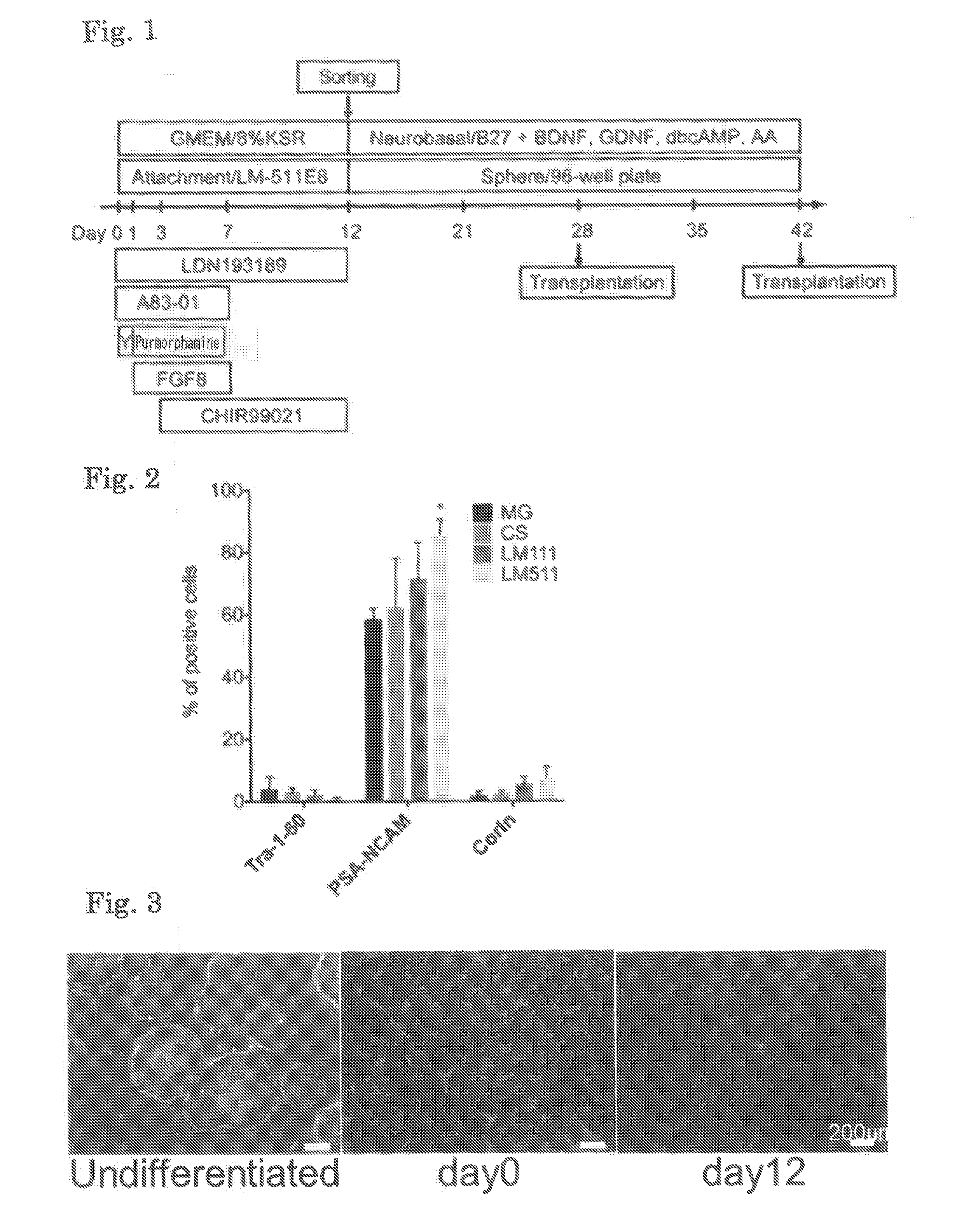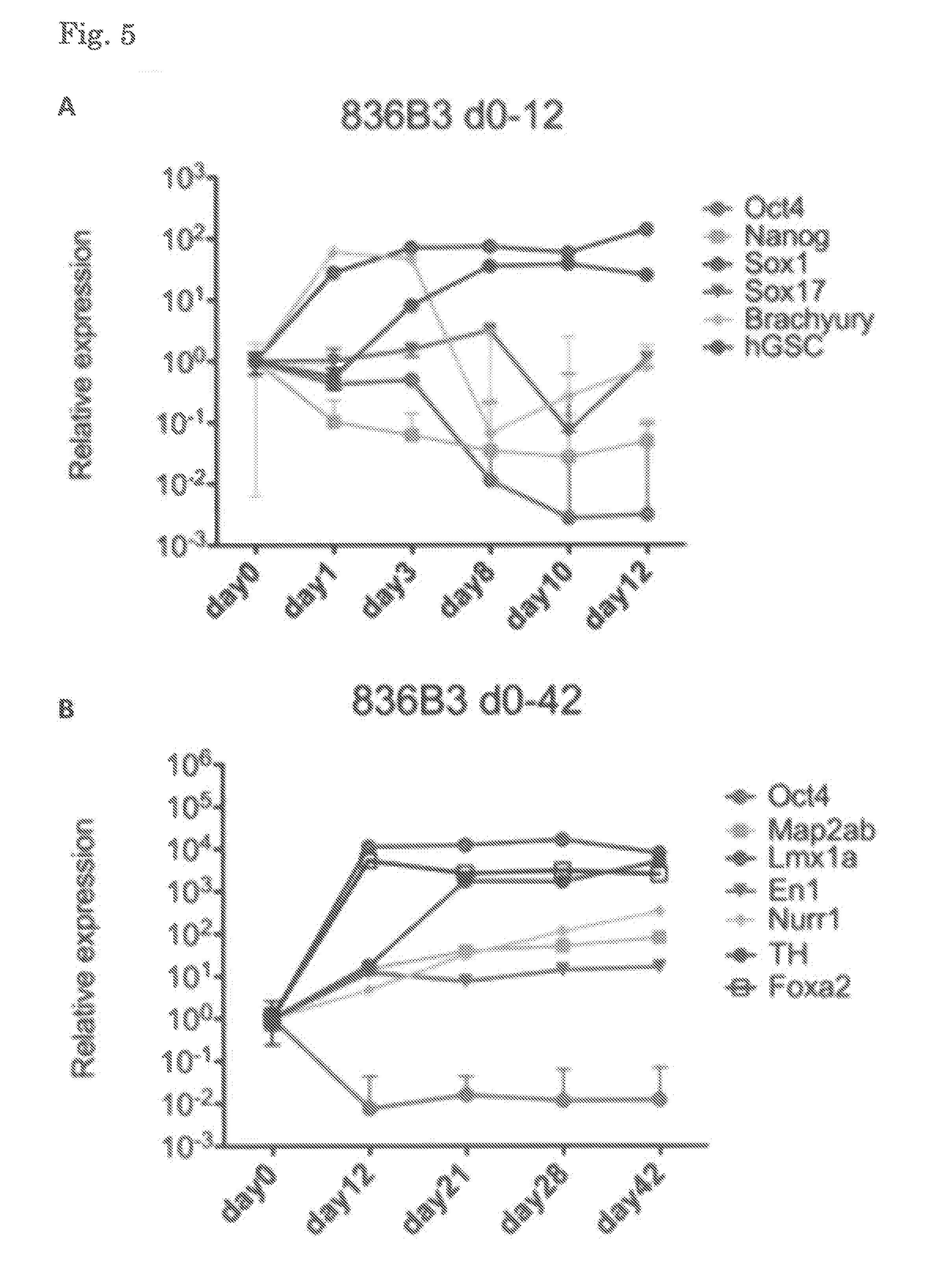Method for inducing dopaminergic neuron progenitor cells
a dopaminergic neuron and progenitor cell technology, applied in the direction of embryonic cells, non-embryonic pluripotent stem cells, drug compositions, etc., can solve the problems of high infection risk, method needs improvement, formation of benign tumors, etc., and achieve high survival rate
- Summary
- Abstract
- Description
- Claims
- Application Information
AI Technical Summary
Benefits of technology
Problems solved by technology
Method used
Image
Examples
example 1
Cells and Culture
[0147]Human ES cells (KhES-1) were obtained from Institute for Frontier Medical Sciences, Kyoto University (Suemori H, et al. Biochem Biophys Res Commun. 345:926-32, 2006). 404C2 and 836B3, which are human iPS cells produced by introducing Oct3 / 4, Sox2, Klf4, L-MYC, LIN28, and p53shRNA to human fibroblasts using an episomal vector, were received from Prof. Yamanaka at Kyoto University (Okita et al., Nat Methods. 8: 409-412, 2011).
[0148]The ES cells and the iPS cells were cultured by the method according to the method described in Miyazaki T et al. (Nat Commun. 3: 1236, 2012). Briefly, these cells were cultured in 6-well plates coated with Laminin 511E8.
[0149]The thus obtained ES cells or iPS cells were dissociated using TrypLE CTS (Life Technologies), and transferred to a 6-well plate coated with Laminin 511E8 (iMatrix-511, Nippi) in an amount of 4×104 cells per well. The cells were then cultured by the above-described culture method for four days, and, after confir...
example 2
Cell Culture
[0168]ES cells (Kh-ES1) were dissociated using TrypLE CTS (Life Technologies), and the whole cells were transferred to a 6-well plate coated with Laminin 511E8. The cells were then cultured in Basal Medium A (GMEM supplemented with 8% KSR, 1 mM sodium pyruvate, 0.1 mM MEM non-essential amino acid, and 0.1 mM 2-mercaptoethanol) supplemented with 10 μM Y-27632, 0.1 μM LDN193189, and 0.5 μM A83-01. One day after the beginning of the culture (Day 1), the medium was replaced with Basal Medium A supplemented with 0.1 μM LDN193189, 0.5 μM A83-01, 2 μM purmorphamine, and 100 ng / mL FGF8. Three days after the beginning of the culture (Day 3), the medium was replaced with Basal Medium A supplemented with 0.1 μM LDN193189, 0.5 μM A83-01, 2 μM purmorphamine, 100 ng / mL FGF8, and 3 μM CHIR99021. Seven days after the beginning of the culture (Day 7), the medium was replaced with Basal Medium A supplemented with 0.1 μM LDN193189 and 3 μM CHIR99021. On Day 12 (12 days after the beginning ...
example 3
Cell Culture
[0173]ES cells (Kh-ES1) were dissociated using TrypLE CTS (Life Technologies), and 4×105 cells were then transferred to a 6-well plate coated with Laminin 511E8. The cells were then cultured in StemFit medium (Ajinomoto) supplemented with 10 μM Y-27632. Four days later, the medium was replaced with the above-described Basal Medium A supplemented with 0.1 μM LDN193189 and 0.5 μM A83-01 (Day 0). One day after the beginning of the culture (Day 1), the medium was replaced with Basal Medium A supplemented with 0.1 μM LDN193189, 0.5 μM A83-01, 2 μM purmorphamine, and 100 ng / mL FGF8. Three days after the beginning of the culture (Day 3), the medium was replaced with Basal Medium A supplemented with 0.1 μM LDN193189, 0.5 μM A83-01, 2 μM purmorphamine, 100 ng / mL FGF8, and 3 μM CHIR99021. Seven days after the beginning of the culture (Day 7), the medium was replaced with Basal Medium A supplemented with 0.1 μM LDN193189 and 3 μM CHIR99021. On Day 14 (14 days after the beginning of...
PUM
| Property | Measurement | Unit |
|---|---|---|
| concentration | aaaaa | aaaaa |
| concentration | aaaaa | aaaaa |
| concentration | aaaaa | aaaaa |
Abstract
Description
Claims
Application Information
 Login to View More
Login to View More - R&D
- Intellectual Property
- Life Sciences
- Materials
- Tech Scout
- Unparalleled Data Quality
- Higher Quality Content
- 60% Fewer Hallucinations
Browse by: Latest US Patents, China's latest patents, Technical Efficacy Thesaurus, Application Domain, Technology Topic, Popular Technical Reports.
© 2025 PatSnap. All rights reserved.Legal|Privacy policy|Modern Slavery Act Transparency Statement|Sitemap|About US| Contact US: help@patsnap.com



